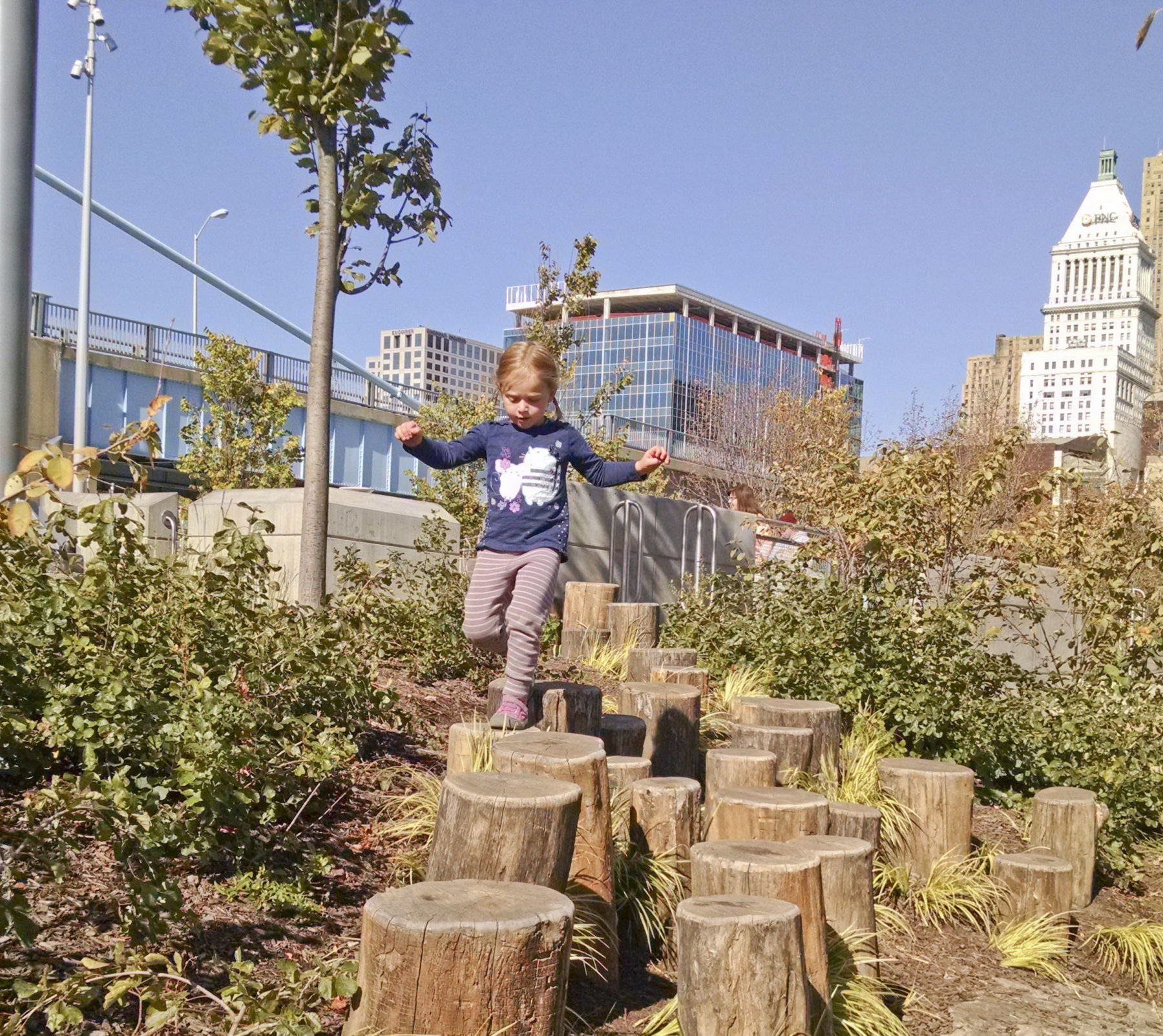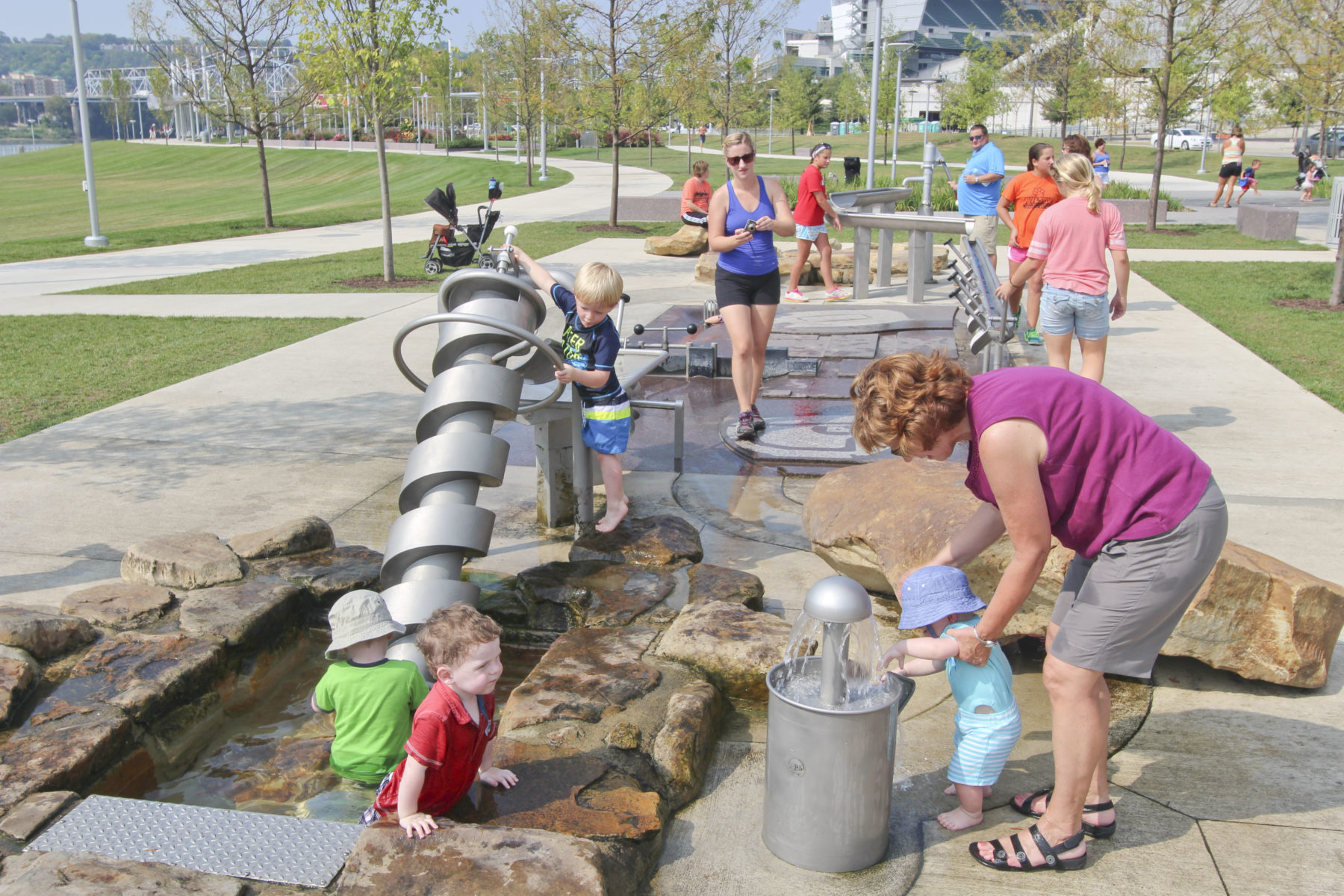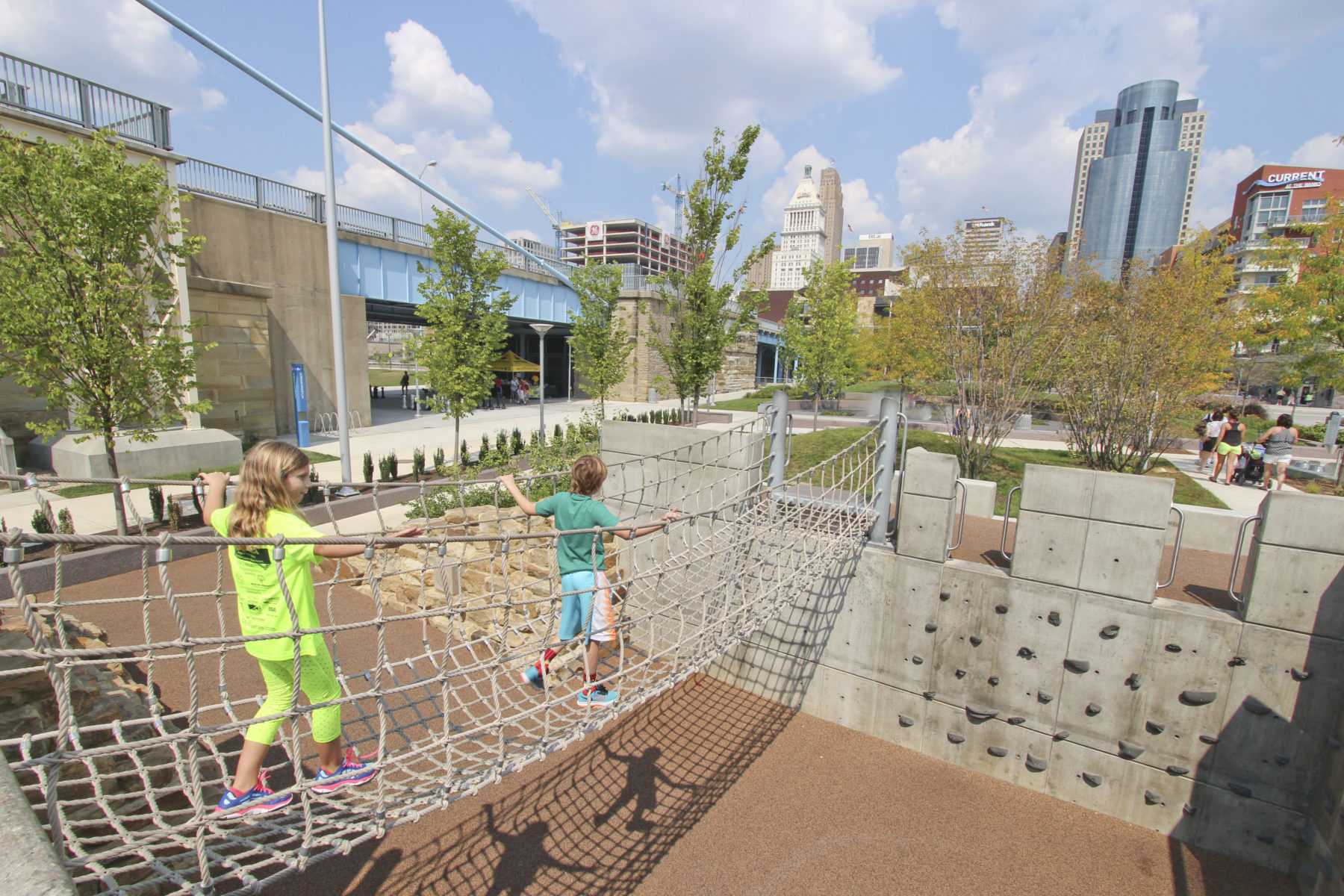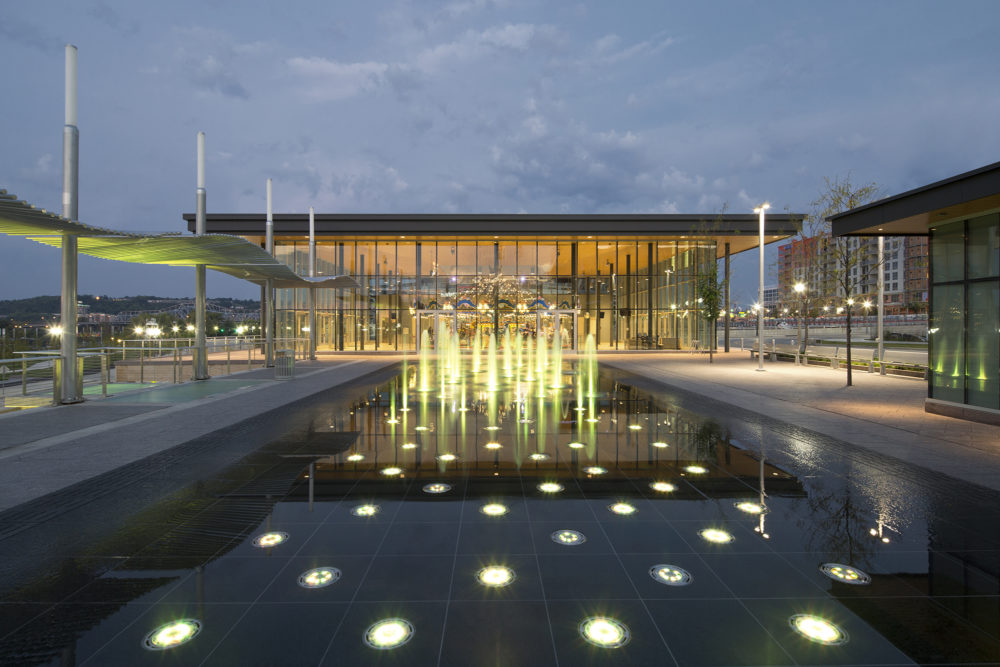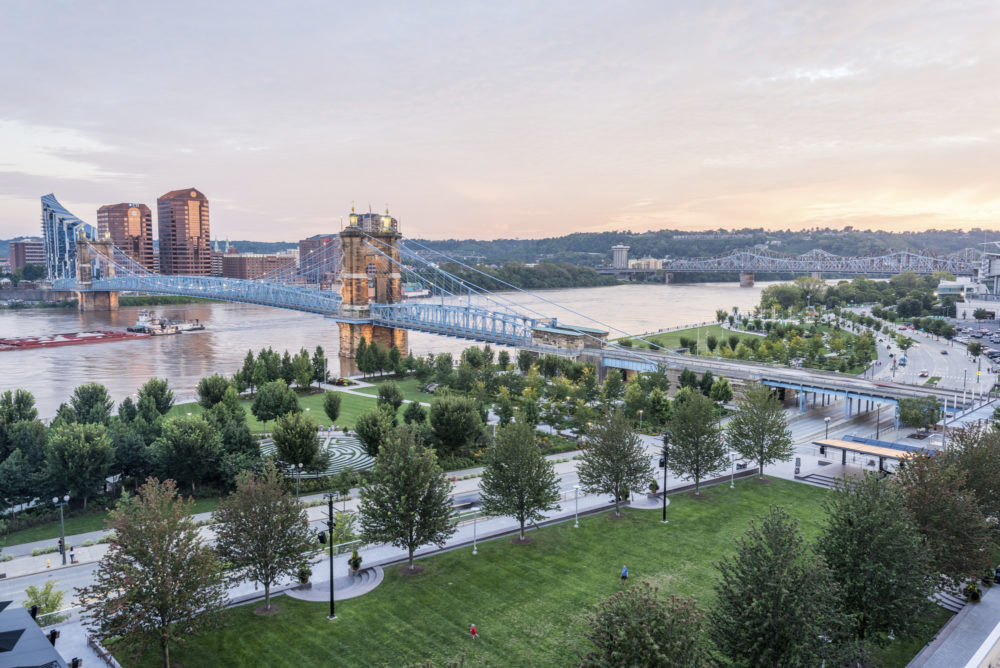We returned to Boston with a substantial amount of data, both qualitative and quantitative. As we comb through it, we keep making new discoveries, but four key trends have emerged. First, the playscapes at Smale have a high level of intergenerational integration. At most standard playgrounds, there is a simple pattern: children play on the plastic structure, while parents mill about on the outskirts. Conversely, at Smale the densities of children and adults were relatively even across all play zones. Adults weren’t just watching children on the flying pig, they were climbing up for a ride themselves or helping to pull on the wings to create the flying motion. At the climbing walls and log climbing feature, adults were both spotting children and trying out the holds themselves. One father told us: “[this park] is fun and challenging, so different than our neighborhood tot lot…I can’t help but join in the playing!” The perception of risk also made many parents stick more closely to their children than usual. At times children were asking for help with a difficult move, and at other times parents were nervously hovering and telling children to be careful.
Second, design layout has a strong effect on patterns of movement. The PNC/Heekin adventure playscape, on the east side of the bridge, is designed as one fluid playscape, with different play elements linked together in a similar way to a climbing structure. Children moved in fast, iterative, and looping paths here. Parents traveled loosely with their kids, but also stopped to watch at times from key vantage points, like the bottom and top of the slides or the ends of the valley. The P&G goVibrantscape, on the west side of the bridge, is laid out as separate play “rooms” arranged along the central spine of the historic Water Street. Parents and children traveled in family groups from room to room, rarely returning to a room after leaving it. The marked difference between movement patterns on the east and the west speaks to the rise of the continuous play concepts in the 1980s. Early playgrounds tended to be object focused: a swing, a see-saw, a ladder, and slide element – all placed separately on a flat plane. Continuous play, credited to Steve King of Landscape Structures, captures the idea of linking play moments together into a fluid experience: from the pinnacle of one feature you can always see another adventure. This thinking gave rise to the kind of conglomerate play structure so familiar on today’s standard playgrounds, but is also useful in designing custom playscapes that will keep children running from one exciting experience to the next.
Third, despite design considerations and operational measures in place, some kids will use the playscape in unintended ways. On standard playgrounds, it’s common to see kids climbing backwards up the slides, monkeying around to the outside of high guardrails and swinging from the tops of shade trellises. Some children are hard-wired to make their own challenge, even if that appears dangerous or undesirable to adults. This holds for Smale, where children who want to be creative have plenty of opportunities for upping the ante, despite the fact that the custom playscape meets all safety standards. One group of boys used the Heekin playscape as a parkour training ground, doing back flips off the rocks, frog-leaps over the climbing logs and vigorous swinging on the rope bridge. Children use the sloped concrete next to the slides as much as the slides themselves, and climb to the very top of the pig rather than just inside the cockpit. Instead of just working together to get the balancing disc level, some groups play a game where one person spins the disc in an attempt to get others to lose their balance and fly off. Although these behaviors could be regarded as simply dangerous, they are also markers of creativity and innovation and an important part of children claiming the space as their own.
Finally, constructive play in the playscape is just as valuable as challenging physical activity. The new generation of adventure playgrounds, like Heekin, excel at inspiring physical activity, a sense of risk and the feelings of pride that go along with accomplishing a difficult challenge. Our play typology mapping of the Smale playscapes revealed active physical play occurring across the entire playscape. But constructive play, where children are experimenting and making discoveries is essentially isolated to the water play map. Although our data from a cool October weekend indicated only an average play density at the water map, we heard again and again from stakeholders and families how hugely popular the area is during the summer. One caregiver who runs a nearby daycare told us, it was “the perfect place to get wet [and kept the kids] interested for so long. [It was] always so crowded…I wish it were bigger.” Over the course of a weekend we witnessed countless moments of experimentation, creativity and discovery as children pumped, dammed, diverted, released and splashed water. The air was full of questions like “what happens if…?” and declarations like “look what I did!”. One girl’s father watched her open and close spigots in a certain order and asked her what she was doing. “I’m engineering,” she told him matter-of-factly. Constructive play is critical for nurturing the kind of creative thinking currently in decline,3 and there is clearly an unmet appetite for more of it in the park.
These four big take-aways gloss over a million nuances of the post-occupancy data, but together they highlight how the park has developed a life of its own. As designers, funders, clients and stakeholders – we all dream big about what a park can be, but in the end it is the children, families, and community that really define what it is. How they use the playscape, what they love and what they neglect – these are critical drivers of the park’s future, and also key learning moments for future designs. Sasaki is currently developing partnership models with a local university to continue gathering post-occupancy data throughout the coming summer. At the same time we are already applying thinking around layout, unintended uses and constructive play to new playscape projects.
As the sun starts to shift behind Paul Brown stadium casting long shadows in the park, I wrap up a final interview and tuck away my clipboard. Despite the imminent dusk and the cool air, there are still families enjoying the park. Tess is over at the water play map: she has made friends with another little girl, perhaps five years old, and they have been moving water together for almost 30 minutes, a near-eternity for the preschool bracket. I hear Tessa’s friend shout “are you ready?” and Tessa nods vigorously, her eyes fixed on the stainless steel channel in front of her. As the friend begins pumping water, I walk closer and see that they have placed two twigs in the channel. “Is it working?” the friend asks, and then, unable to contain herself, stops pumping and runs over to see. The three of us watch the water flood the channel, lifting the twigs and carrying them to the end where the girls have left one rubber stopper open. The first twig spins and dives neatly through the hole to fall on the granite map below. The second gets caught sideways and remains as the last of the water drains out. “One boat did the waterfall, and one just did the rapids” explains Tess, and they both laugh.
The friend bounds off to retrieve the sticks, but Tessa stays close. “Mama”, she says, leaning her head into my hip, “I’m tired.” And it’s no surprise: she has been playing hard since nine-thirty in the morning.
Maria Montessori, founder of the popular pedagogy that bears her name, said famously “play is the work of the child,” and today I believe it wholeheartedly. Tessa, and her peers, numbering more than eight-hundred that day, have explored every inch of the park. They have done many of the things we designers might have expected, and have also innovated and discovered new ways of playing in the space that we never could have imagined.
As we begin to climb the steps up to downtown Cincinnati, Tessa turns around and tugs my hand: “But can we come back tomorrow?” As it turns out, we can: this is the perfect collision between work and play for both of us.
–
Sources:
(1) The Trust for Public Land, Center for City Park Excellence, 2014 City Park Facts: bit.ly/2bfn2R7
(2) Journal of Pediatrics, Societal values and policies may curtail preschool children’s physical activity in child care centers. Copeland, et al. 10.1542/peds. 2011-2102
(3) Creativity Research Journal, The Creativity Crisis: The Decrease in Creative Thinking Scores on the Torrance Tests of Creative Thinking. Kyung Hee Kim, 23:4, 285-295. 2011
(4) Evolutionary Psychology, Children’s Risky Play from an Evolutionary Perspective: The Anti-Phobic Effects of Thrilling Experiences. Sandseter, et al. 9(2): 257-284. 2011
(5) The Atlantic Magazine, The Overprotected Kid. Rosin. April 2014: theatln.tc/2bfq2x2
(6) International Journal of Environmental Research and Public Health, What is the relationship between risky outdoor play and health in children? A systematic review. Brussoni et al. 12(6), 6423-6454. 2015

